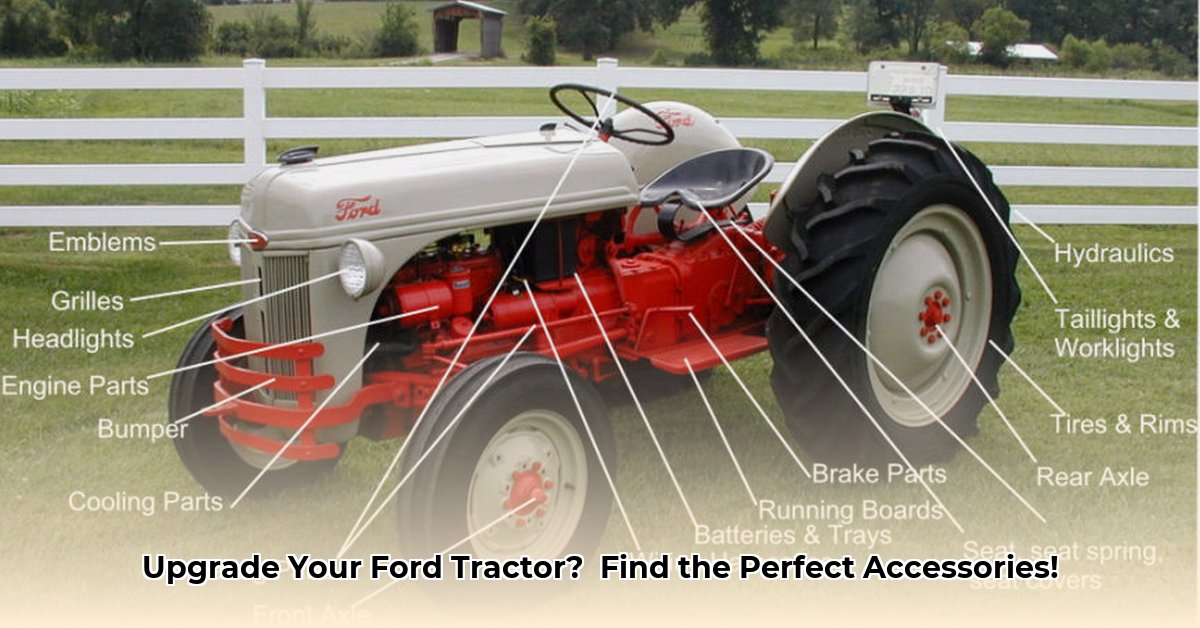
Finding the perfect accessories for your Ford tractor can be overwhelming. With countless attachments available, from tillage implements to harvesting tools and comfort enhancements, choosing the right ones for your needs and budget can feel like navigating a maze. This buyer's guide will help you navigate this landscape, ensuring you find the perfect tools to boost your farm's efficiency and productivity. For older models, check the Ford 8N firing order for proper maintenance.
Understanding Your Tractor Accessory Needs
Before diving into the world of Ford tractor attachments, it's crucial to understand your farming operations. What are your primary tasks? Are you primarily focused on land preparation, planting, harvesting, or a combination of these? Knowing your needs helps you prioritize accessories. For example, a large-scale grain farmer will have different needs than someone with a small orchard. Consider these pivotal points:
- Farming Focus: Identify your main farming activities (e.g., tillage, planting, harvesting). This will significantly narrow your accessory search.
- Tractor Model and Year: This is paramount. Compatibility is dictated by your tractor's specifications, impacting the available options. Check your manual or the tractor's identification plate. Don't skip this step!
- Budget: Set a realistic budget. High-quality attachments typically cost more upfront but often offer greater durability and longevity.
Types of Ford Tractor Accessories
Ford tractor accessories are diverse but can be categorized for easier navigation:
- Tillage Implements: These prepare the land for planting. Examples include plows, discs, and harrows, each suited to different soil types and planting methods.
- Planting Equipment: These tools efficiently place seeds into the ground. Examples include planters and seed drills, with various designs for different crop types.
- Harvesting Attachments: These gather your crops. Examples are combines, reapers, and balers, each tailored to specific crops.
- Maintenance Accessories: Essential for keeping your tractor and attachments in peak condition. Filters, belts, fluids, and other maintenance items fall under this category.
- Comfort and Convenience Accessories: Enhance your working comfort. Examples include LED lights, comfortable seats, and even cupholders. While not essential, they can drastically improve your daily experience.
Finding the Right Fit: Compatibility is Key
Compatibility is crucial. An attachment designed for a 1960s Ford 8N will likely not work with a modern 5000 series tractor. Here's how to ensure compatibility:
- Identify Your Tractor: Note the model and year of your tractor.
- Consult the Owner's Manual: The manual details compatible attachments.
- Online Resources: Websites specializing in tractor attachments can offer compatibility guides. Everything Attachments (https://www.everythingattachments.com/ford-tractor-equipment-s/3791.htm) is a good starting point. However, always cross-reference this information with the official Ford documentation.
- Check Attachment Markings: Many attachments display compatible tractor models.
Top Accessory Picks: Recommendations Based on Experience
Choosing from numerous options can be daunting. Here are some general examples (specific product recommendations require more detailed research based on your exact tractor model and needs):
Tillage: A heavy-duty disc harrow is versatile for various soil types, offering consistent soil preparation. However, it requires more tractor power and represents a slightly higher initial investment.
Planting: Precision planters offer accurate seed placement, reducing waste and improving germination rates. While more complex than simpler planters, this precision translates to increased yields.
Note: These are examples; thorough research based on your requirements is essential. Product names and specific details should be added based on in-depth research of available options.
Making Your Purchase: Budgeting and Other Considerations
Before purchasing, consider these factors:
- Budget: Set realistic spending limits.
- Frequency of Use: Invest in durable, high-end attachments for frequent use, and consider more affordable options for infrequent tasks.
- Specific Needs: Choose accessories precisely matched to your farming practices and crop types.
- New vs. Used: New attachments are reliable but expensive. Used attachments offer cost savings but require careful inspection.
Maintaining Your Investment
Regular maintenance extends the lifespan of your attachments. Clean them after use, lubricate moving parts as needed, and store them properly. Refer to the manufacturer's recommendations for specific guidance. Neglecting maintenance can result in premature wear and tear, leading to costly repairs.
Conclusion: Empowering Informed Decisions
Choosing the right Ford tractor attachments is a significant investment. By understanding your farming needs, ensuring compatibility, and performing thorough research, you can select accessories that optimize farm productivity and longevity. Remember, continuous learning and awareness of new technology are crucial for staying ahead in modern agriculture.